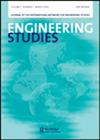‘We’re supposed to be at the forefront’: a multiple case study exploring how institutional context shapes engineering diversity and inclusion initiatives
IF 1.3
3区 工程技术
Q2 EDUCATION, SCIENTIFIC DISCIPLINES
引用次数: 1
Abstract
AbstractResearch suggests the normative culture of engineering perpetuates the marginalization of individuals with excluded identities, contributing to a lack of diversity in academia and the workforce. As evidenced by recent funding opportunities, stakeholders view diversity and inclusion (D&I) as critical to broadening participation, and many engineering units have espoused their commitment to D&I efforts. However, additional research is needed to better understand how institutional contexts shape D&I efforts occurring in academic engineering units. This multiple case study examined engineering units at three U.S. universities that received the same National Science Foundation grant to cultivate an inclusive engineering culture. Drawing from the field of organizational theory, I analyzed data from 11 interviews and 209 pages of documents to understand how university context shaped engineering D&I efforts. The theory of neoinstitutionalism was used as a lens to understand similarities and differences among the cases. Findings suggest D&I efforts were heavily shaped by institutional contexts including the desire for prestige, availability of resources, and pressure from internal and external stakeholders. Implications for policymakers, funding agencies, and engineering leaders point to the need to re-imagine markers of engineering education legitimacy.KEYWORDS: Diversity and inclusionEngineering education reformNeoinstitutionalism Disclosure statementNo potential conflict of interest was reported by the author(s).Notes1 ‘National Science Foundation’.2 Leydens and Lucena, Engineering Justice.3 Lezotte, “Making Sense of Diversity and Inclusion in Engineering.”4 Ibid.5 DiMaggio and Powell, “The Iron Cage Revisited.”6 Ibid. and March, “Footnotes to Organizational Change.” Also see Meyer and Rowan, “Institutionalized Organizations.”7 Suchman, “Managing Legitimacy,” 574.8 Meyer and Rowan, “Institutionalized Organizations”; Meyer and Scott, “Centralization and the Legitimacy Problems of Local Governments.”9 Meyer, Scott, and Deal, “Institutional and Technical Sources of Organizational Structure.”10 Deephouse et al., “Organizational Legitimacy.”11 Mintzberg, “Structure in 5’s.”12 Etzioni, “Authority Structure and Organizational Effectiveness.”13 Cohen and March, “Leadership in an Organized Anarchy.”14 Scott, Organizations.15 Keup et al., “Organizational Culture and Institutional Transformation.”16 Shadle, Marker, and Earl, “Faculty Drivers and Barriers.”17 Argyris, “Initiating Change that Perseveres.”18 Tierney, “Organizational Culture in Higher Education.”19 Kotter, “Leading Change.”20 Clark, “The Contradictions of Change in Academic Systems,” 10121 DiMaggio and Powell, “The Iron Cage Revisited.”22 Meyer and Rowan, “Institutionalized Organizations,” 341.23 Daft and Weick, “Toward a Model of Organizations as Interpretation Systems”; Pfeffer and Salancik, The External Control of Organizations.24 DiMaggio and Powell, “The Iron Cage Revisited”; Suchman, “Managing Legitimacy.”25 DiMaggio and Powell, “The Iron Cage Revisited.”26 Hawley, “Human Ecology,” 334.27 DiMaggio and Powell, “The Iron Cage Revisited.”28 Ibid.29 Meyer and Rowan, “Institutionalized Organizations.”30 Finnegan and Gamson, “Disciplinary Adaptations to Research Culture in Comprehensive Institutions,” 144.31 Stake, The Art of Case Study Research.32 Hansmann, “Why Do Universities Have Endowments?”33 Stake, The Art of Case Study Research.34 Patton, Qualitative Research & Evaluation Methods.35 Ibid.36 Saldaña, The Coding Manual for Qualitative Researchers.37 Ibid.38 Erlingsson and Brysiewicz, “A Hands-on Guide to Doing Content Analysis”; Hsieh and Shannon, “Three Approaches to Qualitative Content Analysis.”39 Altheide et al., “Emergent Qualitative Document Analysis,” 130.40 Saldaña, The Coding Manual for Qualitative Researchers.41 Guba and Lincoln, “Judging the Quality of Fourth Generation Evaluation.”42 Guba and Lincoln, Effective Evaluation, 377.43 Stake, Multiple Case Study Analysis; Miles and Huberman, Qualitative Data Analysis, 173.44 Beckert, “Institutional Isomorphism Revisited,” 156.45 DiMaggio and Powell, “The Iron Cage Revisited.”46 Ashworth, Boyne, and Delbridge, “Escape from the Iron Cage?”47 Meyer and Rowan, “Institutional Analysis and the Study of Education.”48 Meyer and Rowan, “Institutionalized Organizations.”49 DiMaggio and Powell, “The Iron Cage Revisited,” 75.“我们应该站在最前沿”:一个多案例研究,探索制度背景如何塑造工程多样性和包容性倡议
研究表明,规范的工程文化使具有被排斥身份的个人边缘化,导致学术界和劳动力缺乏多样性。正如最近的融资机会所证明的那样,利益相关者认为多样性和包容性(D&I)是扩大参与的关键,许多工程单位已经支持他们对D&I努力的承诺。然而,需要更多的研究来更好地理解制度背景如何影响学术工程单位的D&I工作。这个多案例研究调查了三所美国大学的工程单位,这些大学接受了同样的国家科学基金会资助,以培养包容性的工程文化。从组织理论领域出发,我分析了来自11个访谈和209页文件的数据,以了解大学背景如何影响工程D&I工作。本文以新制度主义理论为视角,分析了案例的异同。研究结果表明,D&I的努力在很大程度上受到制度背景的影响,包括对声望的渴望、资源的可用性以及来自内部和外部利益相关者的压力。对政策制定者、资助机构和工程领导者的影响表明,需要重新构想工程教育合法性的标志。关键词:多样性与包容性工程教育改革新制度主义披露声明作者未报告潜在的利益冲突。注1“国家科学基金Lezotte,“工程中的多样性和包容性的意义”。4同上,5迪马乔和鲍威尔,“重新审视铁笼子。”6同上,3月,“组织变革的脚注”。也可参见Meyer和Rowan的《制度化组织》。7 Suchman,“管理合法性”,574.8 Meyer和Rowan,“制度化组织”;Meyer, Scott, <中央集权与地方政府合法性问题>。9 Meyer, Scott和Deal, <组织结构的制度和技术来源>。10 Deephouse et al.,《组织合法性》。明茨伯格,《5年代的结构》。12 Etzioni,《权力结构与组织效率》。13 Cohen and March, <有组织无政府状态下的领导力>。[14] Scott,《组织文化与制度转型》。16 Shadle, Marker, and Earl, "教员司机和障碍。" 17阿吉里斯,"发起持续的改变。《高等教育组织文化研究》。19 .科特,《领导变革》。20 Clark,“学术体系变革的矛盾”,10121 DiMaggio和Powell,“铁笼再访”。22 Meyer和Rowan,“制度化的组织”,341.23 Daft和Weick,“组织作为解释系统的模型”;24迪马乔和鲍威尔:《重新审视铁笼子》;Suchman,“管理合法性。25迪马乔和鲍威尔,《重访铁笼》26霍利,“人类生态学”,334.27迪马乔和鲍威尔,“重新审视铁笼子。”28同上29 Meyer和Rowan,“制度化的组织”。[30]费尼根和甘森,“综合性机构对研究文化的学科适应”,《案例研究的艺术》,[32]汉斯曼,“为什么大学有捐赠基金?”33 Stake,案例研究的艺术。34 Patton,定性研究与评估方法。35同上。36 Saldaña,定性研究人员编码手册。37同上。38 Erlingsson和Brysiewicz,“做内容分析的实践指南”;“质性内容分析的三种方法”。39 Altheide et al.,“紧急定性文件分析”,130.40 Saldaña,《定性研究人员编码手册》。41 Guba and Lincoln,“判断第四代评估的质量”。42古巴和林肯,有效评价,377.43股权,多案例研究分析;迈尔斯和休伯曼:《定性数据分析》,173.44贝克特:《重新审视制度同构》,156.45迪马乔和鲍威尔:《重新审视铁笼子》。46阿什沃斯、博因和德尔布里奇,《从铁笼子里逃出来?》47 Meyer和Rowan,《制度分析与教育研究》。48 Meyer和Rowan,《制度化的组织》49迪马乔和鲍威尔,《重访铁笼》,75页。
本文章由计算机程序翻译,如有差异,请以英文原文为准。
求助全文
约1分钟内获得全文
求助全文
来源期刊

Engineering Studies
ENGINEERING, MULTIDISCIPLINARY-HISTORY & PHILOSOPHY OF SCIENCE
CiteScore
3.60
自引率
17.60%
发文量
12
审稿时长
>12 weeks
期刊介绍:
Engineering Studies is an interdisciplinary, international journal devoted to the scholarly study of engineers and engineering. Its mission is threefold:
1. to advance critical analysis in historical, social, cultural, political, philosophical, rhetorical, and organizational studies of engineers and engineering;
2. to help build and serve diverse communities of researchers interested in engineering studies;
3. to link scholarly work in engineering studies with broader discussions and debates about engineering education, research, practice, policy, and representation.
The editors of Engineering Studies are interested in papers that consider the following questions:
• How does this paper enhance critical understanding of engineers or engineering?
• What are the relationships among the technical and nontechnical dimensions of engineering practices, and how do these relationships change over time and from place to place?
 求助内容:
求助内容: 应助结果提醒方式:
应助结果提醒方式:


